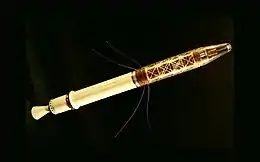Explorer 5
Explorer 5 was a United States satellite with a mass of 17.24 kg. It was the last of the original series of Explorers built, designed, and operated by the Jet Propulsion Laboratory.[1]
 Explorer 5 before launch. | |
| Mission type | Earth science |
|---|---|
| Operator | Army Ballistic Missile Agency |
| Mission duration | Failed to orbit |
| Spacecraft properties | |
| Manufacturer | Jet Propulsion Laboratory |
| Launch mass | 16.86 kilograms (37.2 lb) |
| Start of mission | |
| Launch date | August 24, 1958, 06:17:22 UTC |
| Rocket | Juno I |
| Launch site | Cape Canaveral LC-5 |
| Orbital parameters | |
| Reference system | Geocentric |
| Regime | Medium Earth |
| Epoch | Planned |
Explorer program | |
It launched atop a Juno I rocket on August 24, 1958 from Launch Complex 5, but failed when the rocket's first stage collided with its second stage after separation, causing the upper stage firing angle to be off.[2]
Explorer 5 had been intended to be one of two satellites used to gather data for Project Argus.
References
- Jet Propulsion Laboratory, "Explorer 5"
- "Past Missions - Explorer 1-5". Jet Propulsion Laboratory. Retrieved 2008-02-03.
This article is issued from Wikipedia. The text is licensed under Creative Commons - Attribution - Sharealike. Additional terms may apply for the media files.
.png.webp)